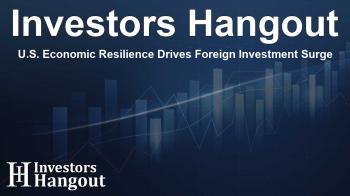U.S. Economic Resilience Drives Foreign Investment Surge

U.S. Economic Resilience Drives Foreign Investment Surge
By Andrea Shalal
The U.S. economy is showcasing remarkable strength in its recovery following the COVID-19 pandemic, leading to an increased interest from global investors seeking safe havens for their capital. According to recent insights from the White House, this demand has significantly bolstered the U.S.'s position in global financial flows.
Rising Attraction for Foreign Investment
The latest report from the Council of Economic Advisers illustrates that the U.S. has become an appealing magnet for foreign direct investment. This shift has primarily been fueled by the resilience of the economic recovery, with substantial investments funneled into infrastructure, renewable energy, and semiconductor technologies. Nations such as Canada, Japan, South Korea, and the United Kingdom are leading the charge in this newfound enthusiasm.
The Importance of U.S. Capital Markets
The report emphasizes the growing importance of the United States within global capital markets. The statistics are telling; in 2022-23, the U.S. captured an astonishing 41% of the global gross capital inflows, almost double its pre-pandemic levels. In stark contrast, the overall global capital inflows fell during the same timeframe, reflecting changing dynamics in international finance.
Capital Flow Trends and Currency Potency
While capital inflows have seen fluctuations, the U.S. dollar has consistently retained its status as the world's primary reserve currency, underpinning the nation's economic stability. This trend is bolstered by its vital role in global trade and cross-border transactions, which remain robust despite fears surrounding de-dollarization stemming from recent geopolitical turmoil.
Strength in Numbers: U.S. Dollar's Performance
Since 2022, the dollar has appreciated by 7.4% against a basket of major currencies. This remarkable growth reaffirms the dollar’s positioning as a reliable asset, further supported by high demand for U.S. Treasury securities, which are sought after for their safety and liquidity.
Investment Statistics and Future Outlook
In examining business investment in the U.S., figures reflect a promising trend; about one-third is currently directed towards factory construction. This trend signifies rising productivity and increased business formation, driven largely by favorable international financing conditions.
Record Portfolio Investments
Notably, portfolio investments in equity and debt markets hit a record high of $1.23 trillion in 2023. This is indicative of investor confidence and commitment to U.S. markets. Despite total capital inflows being lower than pre-crisis peaks, the resiliency and adaptability of the U.S. economic landscape remain appealing.
International Contributions and Foreign Direct Investment
In 2023, contributions from foreign entities were most significant from the UK, followed closely by Canada, France, Luxembourg, and Singapore. Among these, South Korea emerged as the dominant player in foreign direct investment, with commitments exceeding $21.5 billion, notably thanks to targeted tax credits under key legislative measures.
Long-term Growth in FDI Stock
The total stock of foreign direct investment into the U.S. has experienced a surge, doubling from $2.1 trillion in 2009 to $5.4 trillion in 2023. This growth reflects the strengthening of U.S. market fundamentals and investor trust in this economic environment.
Conclusion
U.S. firms are also actively expanding overseas, with their foreign direct investment stock reaching $6.7 trillion in 2024, alongside new investments of $364 billion. However, both outbound and inbound investments from China have diminished by 23% over the past six years, highlighting the increasing scrutiny over national security concerns.
Frequently Asked Questions
What factors are driving foreign investment in the U.S. currently?
The strength of the U.S. economic recovery and specific incentives for sectors like clean energy and technology are significant drivers.
Which countries are the largest contributors to U.S. capital inflows?
In 2023, the UK, Canada, France, Luxembourg, and Singapore were the top contributors to U.S. capital inflows.
How has the U.S. dollar performed recently?
The U.S. dollar appreciated 7.4% against other major currencies since 2022, retaining its global reserve currency status.
What role does business investment play in the U.S. economy?
Business investments, particularly in infrastructure and manufacturing, stimulate economic growth, thereby attracting more foreign capital.
What is the outlook for U.S. foreign direct investments?
With favorable economic conditions and legislative support, the U.S. is expected to continue attracting substantial foreign direct investment in the coming years.
About Investors Hangout
Investors Hangout is a leading online stock forum for financial discussion and learning, offering a wide range of free tools and resources. It draws in traders of all levels, who exchange market knowledge, investigate trading tactics, and keep an eye on industry developments in real time. Featuring financial articles, stock message boards, quotes, charts, company profiles, and live news updates. Through cooperative learning and a wealth of informational resources, it helps users from novices creating their first portfolios to experts honing their techniques. Join Investors Hangout today: https://investorshangout.com/
Disclaimer: The content of this article is solely for general informational purposes only; it does not represent legal, financial, or investment advice. Investors Hangout does not offer financial advice; the author is not a licensed financial advisor. Consult a qualified advisor before making any financial or investment decisions based on this article. The author's interpretation of publicly available data shapes the opinions presented here; as a result, they should not be taken as advice to purchase, sell, or hold any securities mentioned or any other investments. The author does not guarantee the accuracy, completeness, or timeliness of any material, providing it "as is." Information and market conditions may change; past performance is not indicative of future outcomes. If any of the material offered here is inaccurate, please contact us for corrections.
